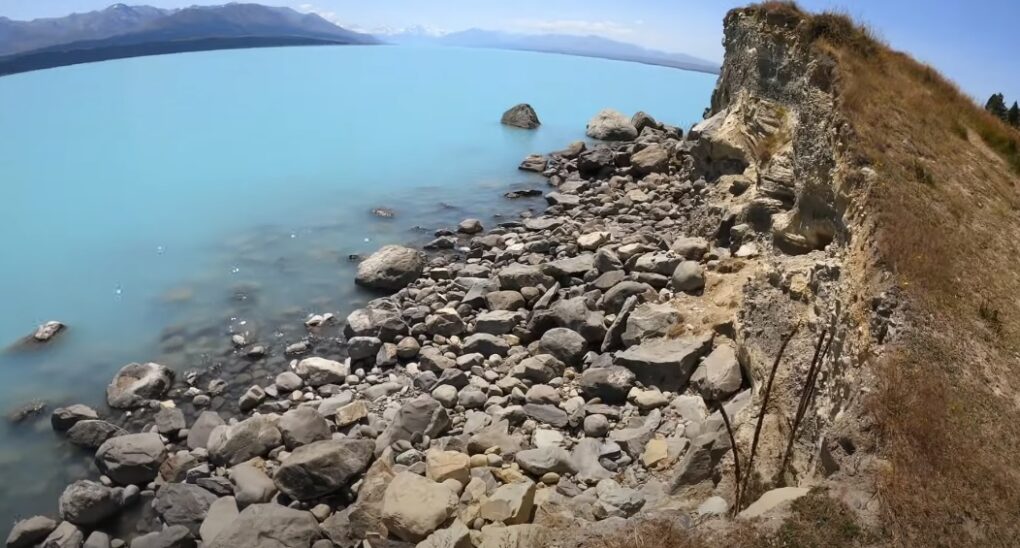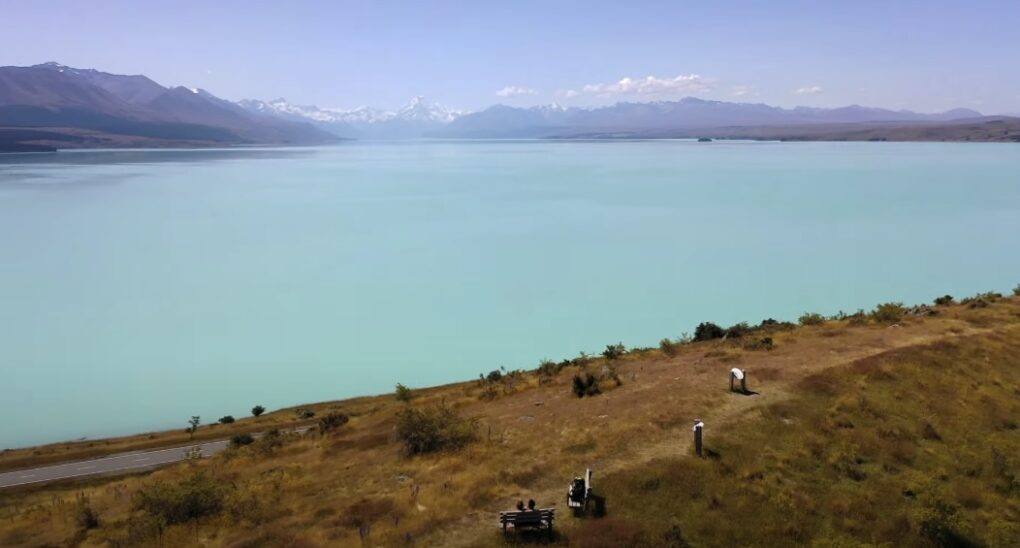Nestled in the heart of New Zealand’s dramatic landscape, Lake Pukaki stands out with its mesmerizingly blue waters, often sparking the question: “Why is Lake Pukaki so blue?” This article explores the unique characteristics that contribute to the lake’s stunning color, delving into scientific explanations and insights from glacial experts.
The Science Behind the Blue
Lake Pukaki’s mesmerizing blue hue captivates visitors from around the world. This remarkable coloration is a result of several scientific processes, primarily influenced by glacial flour and sunlight. Let’s delve into the intricacies of these phenomena:
Glacial Flour
Glacial flour, also known as rock flour, is a crucial component contributing to Lake Pukaki’s striking coloration.
- Definition: Glacial flour consists of fine particles of rock, finely ground by the movement of glaciers;
- Source: These particles originate from the surrounding mountains, predominantly the glaciers of the Southern Alps;
- Impact on Water Color: The suspended glacial flour in Lake Pukaki acts as a light-scattering agent. When sunlight penetrates the lake’s surface, these particles scatter predominantly blue and green wavelengths. This scattering phenomenon is known as Rayleigh scattering, wherein shorter blue wavelengths are scattered more effectively than longer wavelengths like red. Consequently, the lake exhibits a captivating turquoise hue.
Role of Sunlight
Sunlight plays a pivotal role in the manifestation of Lake Pukaki’s vivid blue color. The interaction between sunlight and the suspended glacial flour leads to dynamic color variations.
- Sunlight Interaction: The intensity and hue of Lake Pukaki’s blue color can vary based on the angle of the sun and prevailing weather conditions. When sunlight hits the surface of the lake, it interacts with the suspended glacial flour particles, causing them to scatter and reflect specific wavelengths of light, predominantly blue and green. The angle of the incident sunlight determines the extent of scattering and consequently influences the perceived color of the lake;
- Best Viewing Times: Optimal viewing conditions for experiencing Lake Pukaki’s deepest blue hues typically occur on sunny days, especially during mid-day when the sun is at its zenith. During this time, the sunlight strikes the lake surface directly, maximizing the scattering of shorter blue wavelengths. As a result, the lake appears more intensely blue, showcasing its mesmerizing beauty to observers.
Glacial Influence on Lake Pukaki

The glaciers of the Southern Alps play a pivotal role in shaping the characteristics of Lake Pukaki, influencing its color, water levels, and ecological balance. Understanding the dynamics of glacial influence provides valuable insights into the sustainability and conservation of this natural wonder.
Glacier Dynamics
Glaciers, immense bodies of ice, sculpt the landscape through the process of erosion and deposition. In the case of Lake Pukaki, glaciers contribute significantly to its distinctive blue coloration through the creation of glacial flour.
- Formation of Glacial Flour: As glaciers advance and retreat, they exert tremendous pressure on the underlying bedrock, grinding it into fine particles. These particles, known as glacial flour, are carried by meltwater streams and rivers, eventually finding their way into Lake Pukaki;
- Impact on Water Color: The suspended glacial flour in the lake’s waters acts as a light-scattering agent, predominantly reflecting blue and green wavelengths. This phenomenon results in the mesmerizing turquoise hue for which Lake Pukaki is renowned.
Climate Impact
The delicate balance of Lake Pukaki’s ecosystem is susceptible to changes in climate, particularly concerning glacier dynamics and melt rates.
- Climate-induced Changes: Variations in temperature and precipitation patterns directly influence glacier melt rates. As temperatures rise, glaciers may experience accelerated melting, leading to increased input of glacial flour into the lake;
- Implications for Lake Dynamics: Changes in the amount of glacial flour entering Lake Pukaki can affect its coloration, water clarity, and nutrient composition. These alterations may have cascading effects on the lake’s ecological balance and biodiversity.
Environmental Concerns
The preservation of Lake Pukaki’s pristine beauty and ecological integrity hinges on proactive conservation efforts and sustainable management practices.
- Impact of Global Warming: Rising global temperatures pose a significant threat to the long-term stability of glaciers in the Southern Alps. Diminished glacier size resulting from accelerated melting could reduce the input of glacial flour into Lake Pukaki, potentially altering its color and ecosystem dynamics;
- Need for Conservation: Recognizing the interconnectedness of glaciers, water bodies, and ecosystems, conservation initiatives are essential for safeguarding Lake Pukaki’s environmental health. These efforts encompass habitat preservation, water quality monitoring, and sustainable tourism practices.
Insights from Glacial Experts
Experts emphasize the importance of ongoing monitoring and research to assess the health of glaciers and anticipate future changes in Lake Pukaki’s appearance and ecosystem.
- Monitoring Glacier Health: Continuous monitoring of glacier mass balance, melt rates, and climatic trends provides crucial data for understanding the dynamics of glacial influence on Lake Pukaki;
- Conservation Imperatives: Conservation efforts must prioritize the preservation of not only the aesthetic appeal of Lake Pukaki but also its ecological resilience. By implementing adaptive management strategies and engaging in collaborative stewardship, stakeholders can ensure the long-term sustainability of this iconic natural landmark.
Tourist Experience and Conservation Efforts

To ensure the preservation of this pristine environment for future generations, it’s imperative for visitors to understand how they can contribute to conservation efforts while enjoying their experience.
Visiting Lake Pukaki
Embarking on a journey to Lake Pukaki promises a plethora of activities and awe-inspiring vistas, allowing visitors to forge unforgettable memories amidst nature’s splendor.
- Activities: Lake Pukaki offers a diverse range of recreational pursuits, including kayaking, photography expeditions, and scenic flights. These activities provide visitors with unique perspectives of the lake’s azure expanse and surrounding landscapes, fostering a deeper appreciation for its natural allure;
- Best Times to Visit: While Lake Pukaki captivates visitors year-round, late spring through early autumn presents the most opportune period for exploration. During this time, the weather conditions are generally favorable, facilitating clearer views and optimal conditions for outdoor adventures.
Conservation Initiatives
Preserving the ecological integrity and aesthetic charm of Lake Pukaki necessitates concerted conservation endeavors at both local and visitor levels.
- Local Efforts: Local authorities and environmental organizations are actively engaged in initiatives aimed at safeguarding Lake Pukaki’s water quality and mitigating the impacts of tourism on its fragile ecosystem. These efforts encompass habitat restoration, invasive species management, and sustainable tourism practices;
- Visitor Guidelines: As stewards of the environment, tourists play a pivotal role in minimizing their ecological footprint and preserving the natural beauty of Lake Pukaki for future generations. To this end, visitors are encouraged to adhere to established guidelines, which include staying on designated paths and trails, refraining from littering, and utilizing designated viewing areas to minimize disturbances to wildlife habitats and sensitive ecosystems.
Conclusion
The question “Why is Lake Pukaki so blue?” opens up a fascinating exploration of natural science, environmental issues, and the impact of human activity on one of New Zealand’s most stunning lakes. Understanding these elements not only satisfies curiosity but also underscores the importance of conservation efforts to preserve such breathtaking natural beauty for future generations.
FAQ
The blue color of Lake Pukaki is primarily due to the reflection of blue wavelengths by glacial flour in the water.
Yes, depending on the sunlight and weather conditions, the intensity and shade of blue can vary.
Climate change poses a significant threat by potentially reducing glacier size and, consequently, the amount of glacial flour entering the lake.
Swimming is generally safe, but the water is very cold, even in summer.



